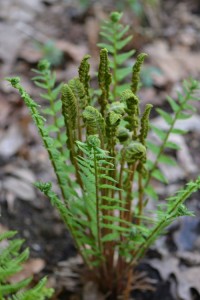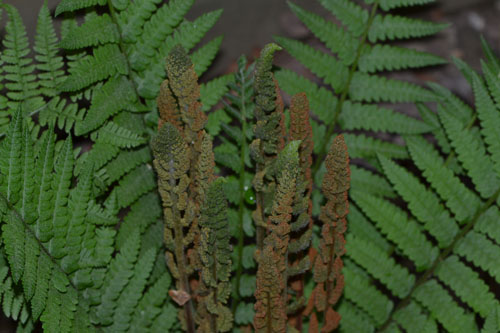 Cinnamon fern is one of the larger ferns we have – I have a handful in the woodland garden, reaching over 4 feet in height. The plants are quite beautiful: The fertile fronds appear first as furry fiddleheads, ultimately becoming stiff, erect, and soon turn a chocolate brown color – very much like a stick of cinnamon. The sterile fronds bend outwards forming a vase-shaped circle enclosing the fertile fronds.
Cinnamon fern is one of the larger ferns we have – I have a handful in the woodland garden, reaching over 4 feet in height. The plants are quite beautiful: The fertile fronds appear first as furry fiddleheads, ultimately becoming stiff, erect, and soon turn a chocolate brown color – very much like a stick of cinnamon. The sterile fronds bend outwards forming a vase-shaped circle enclosing the fertile fronds.
The fuzz on the fern fiddleheads is often used by hummingbirds as a nest liner, and the fiddleheads themselves feed some species of birds and mammals. These are also fit for human consumption, but be aware that the plant does contain some carcinogens – you don’t want to make these part of your daily diet.
Osmunda cinnamomea is present not only in eastern North America but is also found in Asia (Siberia to Vietnam) and South America (Peru to Paraguay). The cinnamon fern is quite old (it has been dated in the geological record at least 75 million years ago and shared the planet with dinosaurs in the Cretaceous period) – it is really a living fossil. The plant itself, or at least the dense wiry rootstock can be hundreds of years old.

Leave a Reply